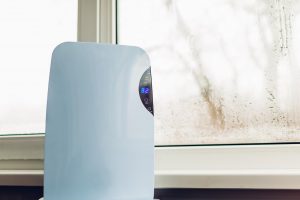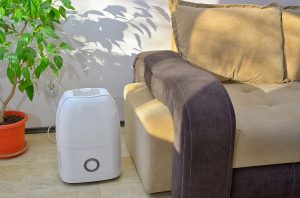Many homes in the UK experience excessive moisture leading to damp walls, condensation on surfaces as well as mould in their homes.
It is especially bad for people who already suffer from allergies or respiratory conditions such as asthma.
If you do not get rid of excessive moisture, it could damage electronics or clothes, and would also leave an unpleasant smell.
The best solution to get rid of damp or excessive moisture is a dehumidifier.
A dehumidifier gets rid of the excessive moisture in the air and helps in maintaining ideal levels of relative humidity in an enclosed space. Since there is a lot of conflicting information out there, here is our guide on everything you need to know about dehumidifiers.
We have also compiled a list of the best dehumidifiers available online to compare.
Contents
- 1 Key Takeaways
- 2 Types of Dehumidifiers
- 3 Dehumidifier FAQ
- 3.1 How Does a Dehumidifier Work?
- 3.2 What Does a Dehumidifier Do?
- 3.3 What Is Relative Humidity?
- 3.4 Where Does the Water in the Air Come From?
- 3.5 What Is the Ideal Humidity Level for My Home?
- 3.6 How Long Will It Take to Get the Moisture under Control?
- 3.7 How Much Water Does a Dehumidifier Remove?
- 3.8 How Do I Know How Big a Dehumidifier I Need?
- 3.9 How Does a Dehumidifier Prevent Mould and Mildew Growth?
- 3.10 What Is the Best Location for My Dehumidifier?
- 4 Heat Pump Source: Reliable Heating and Cooling Solutions
- 5 Conclusion
Key Takeaways
- Excessive moisture in homes can lead to problems like damp walls, condensation, and mould, especially harmful for individuals with allergies or respiratory conditions.
- Dehumidifiers come in different types, including refrigerant, desiccant, and whole-house models, each with unique mechanisms for removing excess moisture from the air.
- Dehumidifiers reduce relative humidity levels in enclosed spaces, helping prevent mould and maintaining a comfortable environment, with ideal relative humidity typically around 50%.
Types of Dehumidifiers
There are three main types including desiccant, refrigerant and whole house. All these types work differently to collect excess moisture in the air.
Refrigerant Dehumidifier
 The working principle is similar to the fridge you have at home. It houses a metal plate which is kept cold with the help of the refrigeration process.
The working principle is similar to the fridge you have at home. It houses a metal plate which is kept cold with the help of the refrigeration process.
There is a fan in the unit which draws in the air from the room, and this air passes over the cool metal plate leading to condensation of the water present in the air.
Over time, this moisture starts dripping into the water collection tank inside the unit. Eventually, the humidity in the room where the dehumidifier is installed is brought down to ideal levels, and then, the unit goes into standby.
These are designed to be used at normal room temperature and do not perform that well in chilly conditions. This is due to the reason that ice starts forming on the metal cooling plates when the temperature drops below 18 degrees C.
There are refrigerant models that can operate in chilly conditions, but the components required for performance at those levels are expensive.
In short, you shouldn’t buy a refrigerant model for use in chilly conditions.
Desiccant Dehumidifier
In these models, a desiccant is used for absorbing water. You must have noticed a small pack of crystals typically labelled as silica gel whenever you order an electronic or other product that can be damaged by moisture. That material inside is known as desiccant.
In this unit, there is a wheel that consists mostly of the desiccant material. It keeps turning slowly through the incoming air, which leads to absorption of moisture by the desiccant.
This wheel of desiccant material also passes through warm air during the rotation which dries the moisture captured in the desiccant. This moisture in the form of water then goes straight to a collection tank though there are models where water can be drained out directly through a plughole.
These are compact and light in size as compared to the refrigerant models. The most significant advantage of these units is their effectiveness in chilly conditions as compared to the refrigerant units.
Desiccant dehumidifiers are perfect for use in spaces with very low temperature such as a garage or a workshop.
The biggest disadvantage of this type of unit is excessive power consumption when compared to the type mentioned above.
Whole House Models
You also have the option of buying a whole-house unit. It is more effective and economical to run as compared to the other units.
These units are installed in the loft space and work by pushing the air down through a discrete grill. This fresh air arriving from the loft forces the damp air out from your home naturally making your house free of excessive moisture. However, these units tend to be expensive as compared to the other two types of dehumidifiers mentioned above.
Dehumidifier FAQ
How Does a Dehumidifier Work?
 Different types of dehumidifiers work differently. The refrigerant units remove excessive moisture from the air by passing it over a cold surface where the moisture condensates and is collected into a collection bucket in the unit.
Different types of dehumidifiers work differently. The refrigerant units remove excessive moisture from the air by passing it over a cold surface where the moisture condensates and is collected into a collection bucket in the unit.
There is also the desiccant method wherein moisture-laden air is passed over a desiccant (water-absorbing material). The excessive water gets absorbed into this material, and when warm air passes through it, the water is removed and is collected into a collection bucket.
What Does a Dehumidifier Do?
A dehumidifier gets rid of excess moisture from the air, and it keeps working until the pre-set level of relative humidity is reached.
A good quality dehumidifier goes into standby mode once the pre-set relative humidity level is reached and it kicks in again when the sensors detect higher moisture levels in the air.
What Is Relative Humidity?
Air can hold a certain amount of water. When the air has the maximum amount of water it can hold, the relative humidity is said to be 100% as it is measured in percentages.
When someone mentions relative humidity, they mean the amount of water that is currently in the air as compared to its maximum capacity.
Temperature levels affect the capacity of air to hold water as warm air is capable of holding more water as compared to cooler air.
Every 10 degrees C fall in the temperature of the air brings down the capacity of the air to hold water by 50%. For example, air at 35 degrees C with a relative humidity of 50% will have 100% relative humidity when the temperature drops down to 25 degrees C.
Where Does the Water in the Air Come From?
Air will always have water though its amount depends on the conditions and other activities such as breathing, showering, washing or cooking. Uncovered fish tanks can also add to the moisture levels in the air.
What Is the Ideal Humidity Level for My Home?
Experts recommend a relative humidity (RH) level of 50% to remain comfortable inside your home.
It will prevent the growth of mould and will also keep your belongings safe. Any drop in RH levels below 50% does not add to your comfort and only leads to wastage of energy.
How Long Will It Take to Get the Moisture under Control?
There is no set answer as everything depends on conditions in the area where the dehumidifier needs to operate.
Suppose you have the right capacity dehumidifier and there are no particular problems. In that case, it should take anywhere from a few days to a week to bring down the humidity levels to comfortable levels.
However, this time scale doesn’t apply to a room that has been flooded. In such situations, it is better to utilise the services of water damage specialists.
How Much Water Does a Dehumidifier Remove?
It depends on the relative humidity in the room, room temperature, as well as power/capacity of the unit.
 If a dehumidifier is rated at 10 L, it doesn’t mean that it will remove 10 L of water in 24 hours. In typical circumstances, the water bucket in a dehumidifier unit needs to be emptied once every two days. However, if there is excessive moisture, you might need to empty it twice or even thrice a day.
If a dehumidifier is rated at 10 L, it doesn’t mean that it will remove 10 L of water in 24 hours. In typical circumstances, the water bucket in a dehumidifier unit needs to be emptied once every two days. However, if there is excessive moisture, you might need to empty it twice or even thrice a day.
How Do I Know How Big a Dehumidifier I Need?
Everything depends on the relative humidity levels and size of the area.
Most manufacturers typically give an estimate in terms of the area for which a particular unit should be effective.
If you have any doubts, always choose a bigger size. Bigger units tend to be more energy-efficient and need to run for fewer hours.
How Does a Dehumidifier Prevent Mould and Mildew Growth?
Mould and mildew need moisture in the air as well as on the surface to grow. A dehumidifier gets rid of the excessive moisture in the air and dries out the surface, thus preventing the growth of mould and mildew spores.
What Is the Best Location for My Dehumidifier?
Most dehumidifiers generate a humming sound when running. If noise levels are a problem for you, consider investing in a whole-house unit.
As far as the position of a portable dehumidifier is concerned, it doesn’t matter. You can place it anywhere, and it should keep working without any issues.
Heat Pump Source: Reliable Heating and Cooling Solutions
At Heat Pump Source, we take pride in our unwavering commitment to serving the UK with top-tier HVAC solutions. From the efficiency of heat pumps and the cool relief of air conditioning to the warmth of boilers, radiators, and underfloor heating, our dedicated team is always at the forefront of innovation. We understand the unique needs of every household and business, and we strive to provide dependable health and cooling products and services that are tailored just for you. Ensuring your comfort and satisfaction is our utmost priority. Whether you have questions, need guidance, or require support, we’re always here to assist. Please don’t hesitate to contact us; we’re eager to be of service.
Conclusion
Understanding how dehumidifiers work and their various types is crucial for maintaining a healthy and comfortable living environment. Excess moisture can lead to a range of problems, from property damage to health issues. By choosing the right type of dehumidifier and maintaining optimal humidity levels, you can effectively combat these issues and ensure a more pleasant and safe home. Remember that while dehumidifiers can significantly improve air quality, it’s essential to consider factors such as room size, humidity levels, and specific needs when selecting the most suitable model for your home.
About the Author
At Heat Pump Source, our articles are the product of a collaborative effort among a team of highly skilled HVAC experts. Our dedicated professionals, hailing from diverse backgrounds in heating, ventilation, air conditioning, and refrigeration, contribute their extensive knowledge and experience to every piece of content. This multidisciplinary approach ensures comprehensive coverage. Our commitment is to deliver authoritative, reliable, and tailored advice to meet the unique needs of every household and business across the UK.

